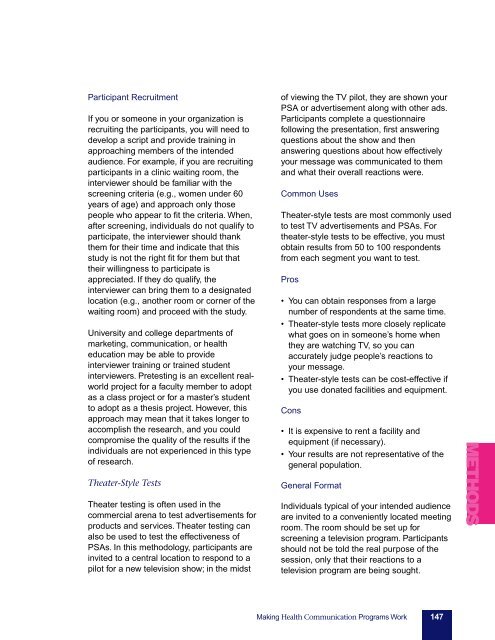pink-book
pink-book
pink-book
Create successful ePaper yourself
Turn your PDF publications into a flip-book with our unique Google optimized e-Paper software.
Participant Recruitment<br />
If you or someone in your organization is<br />
recruiting the participants, you will need to<br />
develop a script and provide training in<br />
approaching members of the intended<br />
audience. For example, if you are recruiting<br />
participants in a clinic waiting room, the<br />
interviewer should be familiar with the<br />
screening criteria (e.g., women under 60<br />
years of age) and approach only those<br />
people who appear to fit the criteria. When,<br />
after screening, individuals do not qualify to<br />
participate, the interviewer should thank<br />
them for their time and indicate that this<br />
study is not the right fit for them but that<br />
their willingness to participate is<br />
appreciated. If they do qualify, the<br />
interviewer can bring them to a designated<br />
location (e.g., another room or corner of the<br />
waiting room) and proceed with the study.<br />
University and college departments of<br />
marketing, communication, or health<br />
education may be able to provide<br />
interviewer training or trained student<br />
interviewers. Pretesting is an excellent realworld<br />
project for a faculty member to adopt<br />
as a class project or for a master’s student<br />
to adopt as a thesis project. However, this<br />
approach may mean that it takes longer to<br />
accomplish the research, and you could<br />
compromise the quality of the results if the<br />
individuals are not experienced in this type<br />
of research.<br />
Theater-Style Tests<br />
Theater testing is often used in the<br />
commercial arena to test advertisements for<br />
products and services. Theater testing can<br />
also be used to test the effectiveness of<br />
PSAs. In this methodology, participants are<br />
invited to a central location to respond to a<br />
pilot for a new television show; in the midst<br />
of viewing the TV pilot, they are shown your<br />
PSA or advertisement along with other ads.<br />
Participants complete a questionnaire<br />
following the presentation, first answering<br />
questions about the show and then<br />
answering questions about how effectively<br />
your message was communicated to them<br />
and what their overall reactions were.<br />
Common Uses<br />
Theater-style tests are most commonly used<br />
to test TV advertisements and PSAs. For<br />
theater-style tests to be effective, you must<br />
obtain results from 50 to 100 respondents<br />
from each segment you want to test.<br />
Pros<br />
• You can obtain responses from a large<br />
number of respondents at the same time.<br />
• Theater-style tests more closely replicate<br />
what goes on in someone’s home when<br />
they are watching TV, so you can<br />
accurately judge people’s reactions to<br />
your message.<br />
• Theater-style tests can be cost-effective if<br />
you use donated facilities and equipment.<br />
Cons<br />
• It is expensive to rent a facility and<br />
equipment (if necessary).<br />
• Your results are not representative of the<br />
general population.<br />
General Format<br />
Individuals typical of your intended audience<br />
are invited to a conveniently located meeting<br />
room. The room should be set up for<br />
screening a television program. Participants<br />
should not be told the real purpose of the<br />
session, only that their reactions to a<br />
television program are being sought.<br />
METHODS<br />
Making Health Communication Programs Work 147


